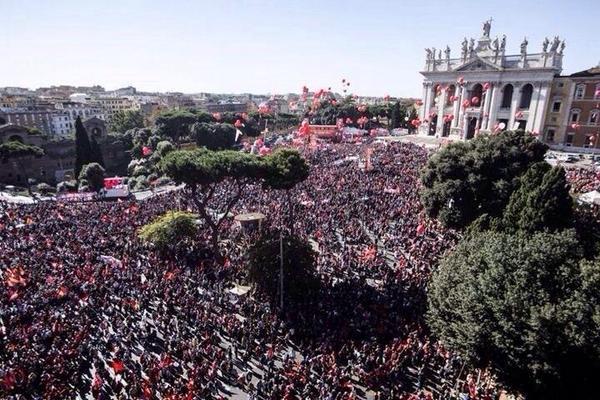The national demonstration called on October 25th in Rome by the CGIL trade union marks a turning point in the class struggle in Italy. It was one of the biggest demonstrations in the history of the Italian trade unions with up to a million taking part. The Italian working class is once again on the march.
However, the importance of the day is not only due to the size of the demonstration. The most important point is that the working class has emerged from its silence and is beginning to make its strength felt at all levels of society. After several years of deafening silence, the workers of Italy are once again raising their voices and it will not be easy to force them back into passivity.
For several years that voice seemed, and indeed was, absent from the political confrontation. Three unelected governments (Monti, Letta, and now Renzi), the diktats from Brussels and Frankfurt, an opposition lead by a clown, the trade union leaders uttering some senseless phrases about the need for “shared solutions”, the left wing fragmented, powerless and impotent – that, on the surface, was the scenario of Italian politics.
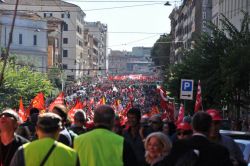 Below the surface of this mediocre theatre, however, there was a growing abyss of unemployment, falling wages, increasing poverty, super-exploitation, cuts, one fourth of industry shut down, factories closing every day, emigration, rage and despair…
Below the surface of this mediocre theatre, however, there was a growing abyss of unemployment, falling wages, increasing poverty, super-exploitation, cuts, one fourth of industry shut down, factories closing every day, emigration, rage and despair…
From time to time, suddenly, some explosion would break the silence: one factory, one town, overnight would go from passivity to the most militant of struggles, only to go back to the previous situation in the space of a few days, apparently without leaving a trace. We, the IMT in Italy, were literally the only tendency on the Italian left, which did not succumb to the mood of pessimism and frustration generated by this situation.
Not surprisingly, the vanguard was particularly affected by this mood: a minority consisting of the most advanced layers had to bear the full weight of the bosses’ offensive, trying to organize a fight back under the very harsh conditions of the economic crisis, rendered even worse by the betrayals of the trade union bureaucracies.
And after all the attempts to create a general front of resistance against these governments failed or fell into the general indifference, it was the government itself that ignited the powder keg. Prime minister Renzi thought that a 41 per cent vote cast for his Democratic Party in the European elections last May was enough of a green light to launch an all out attack on the working class and the trade unions.
The misnamed “Jobs Act” is in effect an attempt – and not the first – to turn the clock back to before 1970, that is to say to abolish what is left of the Labour Code (Statuto dei Lavoratori) which was won after the Hot Autumn of 1969. The objective is to give the bosses a free hand in hiring and firing, to provide them with the most draconian methods of controlling the workforce through new technologies, etc.
To all this we must add the sixth consecutive year of wage freezes in the publict sector, the continuing cuts that will mean further sackings of casual workers in the public sector and in local government, the ongoing privatisation of the education system, the increased taxation on redundancy pay and pension funds, the attempt to privatize the local utilities, and the complete passivity while foreign multinationals close down entire plants…
The “Jobs Act” is to be voted as an Enabling Law, which allows the government to issue the related decrees without further parliamentary debate; and if all this were not enough, Renzi has also launched a frontal attack against the trade union apparatus, and the Cgil in particular, hitting it where it hurts most, that is in their finances, by cutting money they had been receiving for various services they perform in cooperation with the state bureaucracy.
This is the background to the dramatic turn in the situation that we are witnessing these days. In the space of just a few weeks we have gone from listening to speeches by the trade union leaders saying, “strikes are no longer a useful means of struggle” to the calling of local, regional, industry-wide strikes, to the demonstration in Rome and, inevitably, to a general strike in the next few weeks.
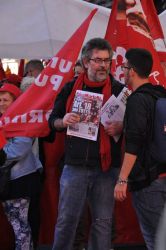 The demonstration in Rome was a like an enormous sigh of relief: “We are here at last, we are speaking for ourselves, we are fighting back, we are moving!”. The mood was both cheerful and serious at the same time, as the joy and the pride at the show of strength on the part of the workers did not lead them to ignoring the scope of the battle and the tasks ahead for one moment. Everyone was well aware that no demonstration, no matter how big, is enough to make the government change its course. Not surprisingly, the crowded square literally exploded when in the final speech General Secretary Susanna Camusso mentioned the general strike.
The demonstration in Rome was a like an enormous sigh of relief: “We are here at last, we are speaking for ourselves, we are fighting back, we are moving!”. The mood was both cheerful and serious at the same time, as the joy and the pride at the show of strength on the part of the workers did not lead them to ignoring the scope of the battle and the tasks ahead for one moment. Everyone was well aware that no demonstration, no matter how big, is enough to make the government change its course. Not surprisingly, the crowded square literally exploded when in the final speech General Secretary Susanna Camusso mentioned the general strike.
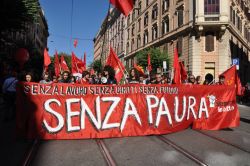 Our organisation was up to the occasion. With around 200 comrades and sympathizers we managed to run three stalls (two in the meeting points and one in S. Giovanni Square), to organize a really lively and militant youth section of the demo unde the slogan “No jobs, No rights, No future – NO FEAR!” where the student comrades uninterruptedly shouted slogans and sang throughout the whole march;
Our organisation was up to the occasion. With around 200 comrades and sympathizers we managed to run three stalls (two in the meeting points and one in S. Giovanni Square), to organize a really lively and militant youth section of the demo unde the slogan “No jobs, No rights, No future – NO FEAR!” where the student comrades uninterruptedly shouted slogans and sang throughout the whole march; 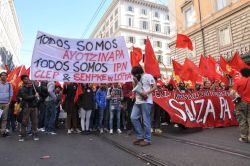 others went around raising money, selling our youth bulletin Sempre in lotta and getting contacts. International solidarity was in the front line of our column with a big banner expressing support for the student movement in Mexico.
others went around raising money, selling our youth bulletin Sempre in lotta and getting contacts. International solidarity was in the front line of our column with a big banner expressing support for the student movement in Mexico.
Other comrades were involved with sections organised by their trade union federations or workplace union commitees, while the re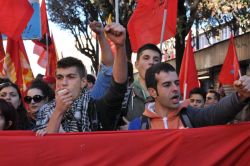 st of us covered the demonstration and the square. We also produced a special T-shirt which was well received, as well as stickers and leaflets. More than 600 copies of FalceMartello were sold and several thousands euros in fighting funds were raised (also by selling sandwiches and beer to the hungry demonstrators and comrades). Dozens of contacts were made in a model intervention.
st of us covered the demonstration and the square. We also produced a special T-shirt which was well received, as well as stickers and leaflets. More than 600 copies of FalceMartello were sold and several thousands euros in fighting funds were raised (also by selling sandwiches and beer to the hungry demonstrators and comrades). Dozens of contacts were made in a model intervention.
More pictures of our intervention here
On the very same day of the demonstration, Renzi called a big convention of his supporters in Florence, a veritable festival of bourgeois reaction posing as the “latest and new” which can save Italy from its decline through privatisations, liberalisations, limitations of the right to strike – a bosses’ festival which exuded spite and hatred for anything remotely linked to the working class and its organisations.
The two gatherings, in Florence and Rome, highlighted in the most graphic manner the class divide, a gap which is now increasing by the day.
scene is therefore set for a major confrontation and whathever the outcome will be, things will not go back to the previous situation. On December 6th to 8th our organisation will hold its national congress. Our main slogans will be – “For a working class party! For the revolutionary alternative!” On these two cornerstones we will build our tendency in the new and stormy situation which is now openingup.

